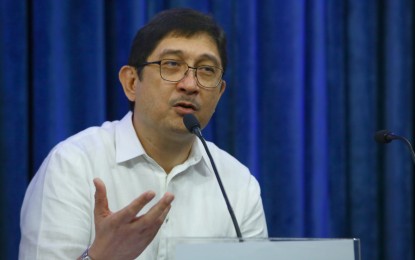
OTC chair Andy Ortega (PNA photo by Joan Bondoc)
MANILA – The Office of Transportation Cooperatives (OTC) on Monday assured that there would be enough public utility vehicles (PUV) operating all routes nationwide, including those without unconsolidated jeepneys, by Feb. 1.
OTC chair Andy Ortega said replacing PUVs that did not comply with the consolidation requirement of the government is a top priority of the Department of Transportation (DOTr) and other government agencies, including local government units (LGUs).
Unconsolidated individual operators have until Jan. 31 only to operate.
“Tuloy tuloy 'yung coordination nila because ang pinaka-importante is we could give 'yung sasakyan (Our coordination is ongoing because it is of utmost importance that we could provide transportation), for the commuting public,” Ortega said in an interview on Bagong Pilipinas Ngayon aired over People’s Television Network.
In the National Capital Region (NCR), he said larger routes with several consolidated operators can cover smaller unconsolidated routes.
“Yung maliliit na ruta, wala halos nag-consolidate, pero dadaanan naman sila ng isang mahabang ruta na mas maraming sasakyan (For the smaller routes, almost no one consolidated, but those are usually passed through by longer routes with more vehicles),” he said.
Special permits will be issued by the Land Transportation Franchising and Regulatory Board (LTFRB) to operators that can also cover routes run by unconsolidated operators.
“Meron din tayong ibang (We also have alternative) modes of transportation which our commuters can take,” he said.
In a separate televised interview over CNN, LTFRB Chair Teofilo Guadiz III said “rescue vehicles” will be dispatched to augment routes with fewer PUVs.
“On February 1, on the assumption that there really is shortage, there are what we call rescue vehicles,” Guadiz said.
The rescue vehicles will be deployed for one to two weeks -- enough time to ensure that there are enough special permits issued, he added.
However, Guadiz said there was a need to trim down PUVs, especially in the NCR, based on several studies by the LTFRB.
“There is what you call an excess in the number of public utility vehicles. There is a need to trim them down. There is a need to recalibrate them in routes where there are less,” he said.
These studies showed instances of “duplication” where some jeepneys ply routes that are already served by other jeepney units plying adjoining or longer routes.
“There are areas in Metro Manila where there is duplication. In these areas, even if you lose jeepneys operating routes from A to B, there are still those from A to C,” he said.
Earlier, transport group Piston claimed there are 395 jeepney routes and 108 UV (Utility Vans) Express routes in NCR that have no consolidated PUVs, in addition to 337 jeepney routes and 68 UV Express routes that have less than 60 percent consolidation.
The government remained firm on its deadline for the consolidation component of the PUV modernization program on Dec. 31, 2023.
If unconsolidated, a PUV will not be issued a confirmation by the LTFRB and will not be able to register with the Land Transportation Office, effectively disallowing its operation. (PNA)
